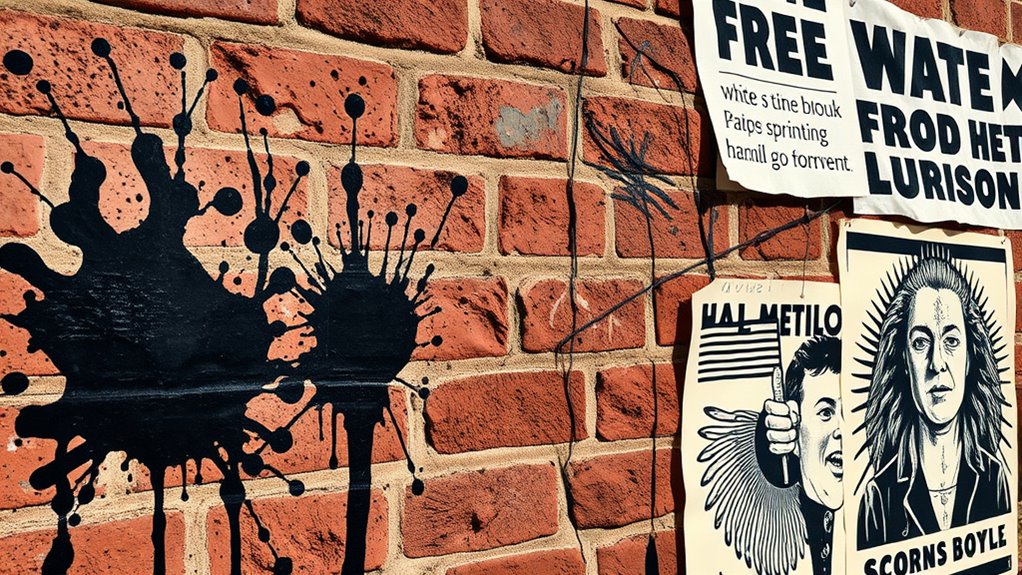Printmaking has long been a powerful tool for activism, allowing you to spread messages quickly and accessibly through bold images and slogans. From historical woodcuts and posters to modern digital designs, the power of ink helps you communicate complex issues, inspire action, and reach diverse audiences. Whether handmade or digital, print’s tangible presence fosters personal connection and keeps social movements alive. Explore further to discover how ink continues to shape activism today.
Key Takeaways
- Printmaking has historically been a vital tool for disseminating revolutionary ideas and rallying support for social movements.
- Techniques like stenciling and relief printing enable affordable, accessible protest materials that can be widely reproduced.
- Iconic posters and flyers use bold visuals and slogans to communicate complex messages quickly and emotionally.
- Modern activism combines digital sharing with handmade prints to expand reach and foster community engagement.
- Printed materials create tangible, lasting impressions that inspire action, especially in communities with limited digital access.
Historical Roots of Protest Printmaking
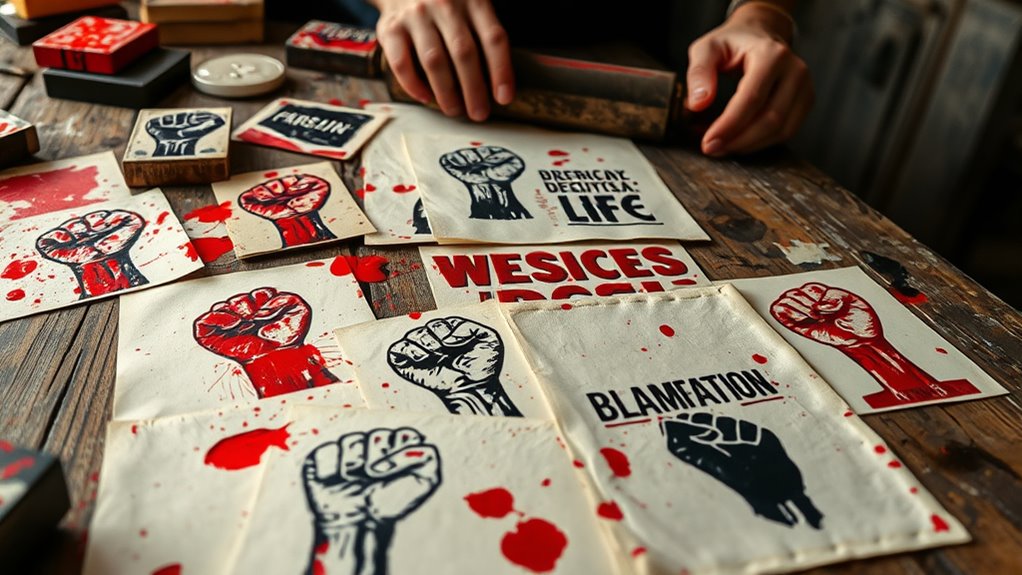
Protest printmaking has deep roots that trace back to the early days of social and political activism. You might not realize it, but this art form has long served as a tool to challenge authority and spread messages. In the 15th and 16th centuries, artists used woodcuts and engravings to distribute revolutionary ideas, often risking their lives. During the Reformation, prints helped spread religious dissent across Europe, giving ordinary people access to alternative viewpoints. In the 18th and 19th centuries, political movements like abolitionism and workers’ rights relied heavily on print materials to rally support. These early efforts proved that printmaking could be a powerful, accessible way to communicate dissent and inspire change, laying the foundation for modern activist art. Understanding the legal considerations surrounding protest art can help activists navigate potential challenges.
Techniques and Materials in Activist Printmaking
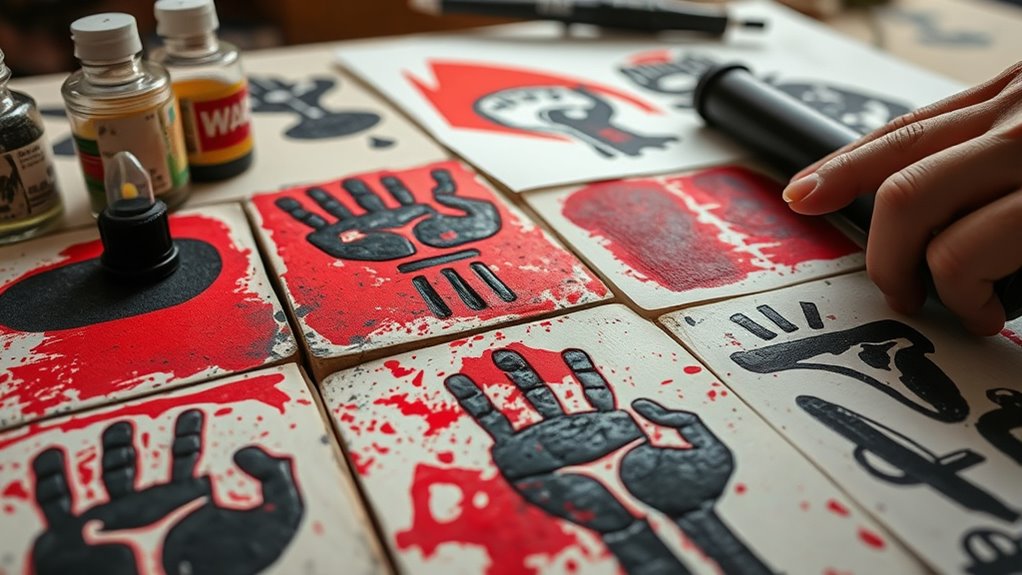
Since protest printmaking has historically relied on accessible and replicable methods to spread messages, understanding the techniques and materials behind these works reveals how activists amplify their voices. You’ll find that simple tools like linoleum blocks, rubber stamps, and stencils make mass production possible. Ink, often soy-based or water-based, is chosen for its affordability and ease of use. Paper and fabric serve as common surfaces, allowing messages to reach diverse audiences. Here’s a quick look at some techniques and materials:
| Technique | Material |
|---|---|
| Relief printing | Linoleum, rubber |
| Stenciling | Cardboard, acetate |
| Screen printing | Mesh screens, emulsion |
| Block printing | Wood, linoleum |
These methods empower activists to craft impactful visuals quickly and affordably. Additionally, understanding the security of printing materials and distribution methods can help protect the integrity of activism efforts.
Iconic Posters and Flyers That Changed Movements
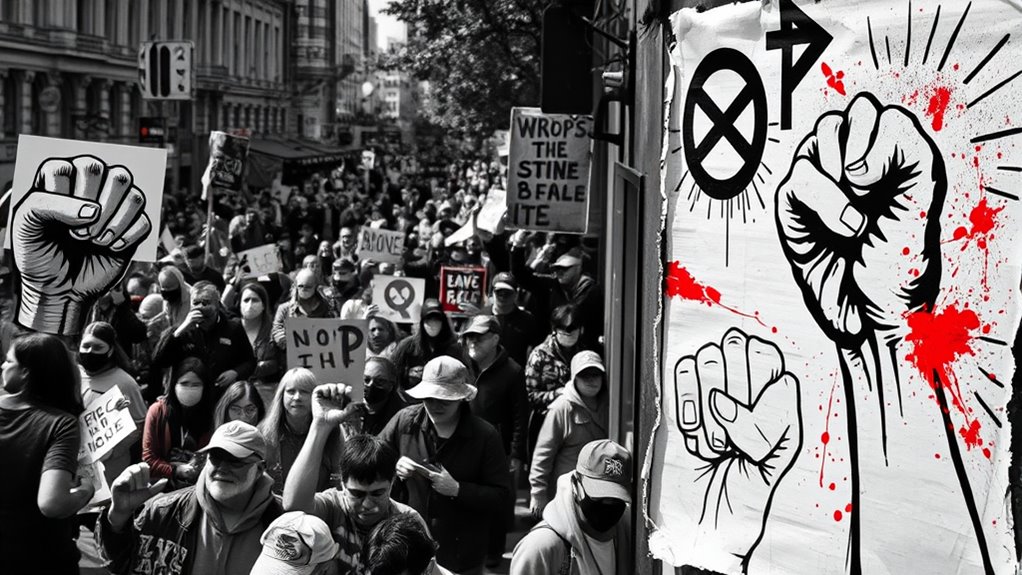
Have you ever wondered how a single poster or flyer can ignite a movement or shift public opinion? Iconic images like the 1968 “Hope” poster of Barack Obama or the striking “Choose Life” anti-abortion flyers became symbols that united and energized communities. These designs use bold graphics, powerful slogans, and vivid colors to grab attention and communicate messages instantly. They often distill complex issues into simple, memorable visuals that resonate emotionally. For example, the “I Am a Man” posters during the Civil Rights Movement conveyed dignity and urgency. Such prints transcend language barriers, spreading ideas quickly and effectively. Their visual impact makes them timeless tools for activism, inspiring action and rallying support at critical moments. Additionally, understanding the importance of visual storytelling enhances the effectiveness of protest prints, allowing creators to craft images that communicate powerful messages even without words.
Modern Digital and Handmade Print Activism
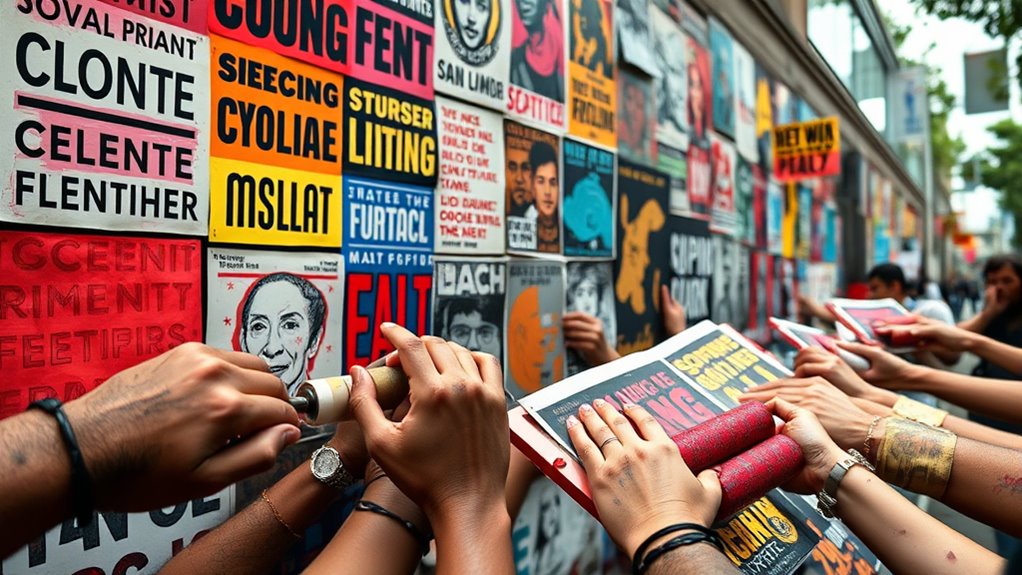
In today’s digital age, activists harness the power of online platforms and handmade prints to spread their messages rapidly and creatively. You can share powerful images, slogans, and videos instantly across social media, reaching global audiences in seconds. At the same time, handmade prints like posters, stencils, and zines remain essential tools for tactile, community-based activism. These physical pieces allow for personal expression and direct engagement, often produced in small batches to maintain authenticity. Combining digital distribution with handmade techniques, you can create a hybrid approach that amplifies your message’s reach while preserving the personal touch that makes print so impactful. The color accuracy of printed materials also plays a crucial role in conveying clear and compelling visuals, ensuring your message resonates strongly. This blend of modern technology and traditional craftsmanship keeps print activism dynamic and relevant in today’s social movements.
The Impact and Continuing Relevance of Print in Social Movements
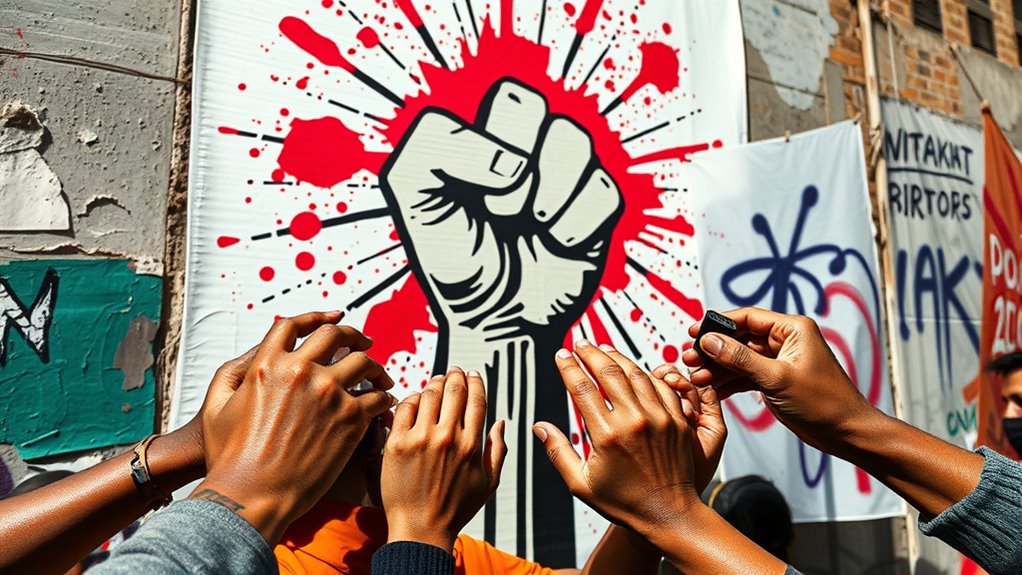
Why does print remain a powerful tool for social movements today? Because it delivers messages directly, tangibly, and broadly. Printed materials like flyers, posters, and zines cut through digital noise, reaching diverse audiences instantly. They evoke a sense of immediacy and permanence that online content often lacks. Print also allows you to craft striking visuals and bold slogans that stick in people’s minds. Its accessibility means you can distribute it in communities where internet access is limited. Plus, the act of printing and sharing creates a sense of solidarity and collective effort. Even now, when social media dominates, print still sparks conversations, motivates action, and leaves a lasting impression that digital alone can’t match. Its enduring significance proves ink and paper remain essential tools for change. Additionally, the rising divorce statistics highlight how print can be used to address and shed light on social issues, fostering awareness and advocacy.
Frequently Asked Questions
How Do Printmakers Choose Symbols for Protest Art?
You choose symbols for protest art by considering their emotional impact and cultural relevance, ensuring they resonate with your message. You research historical and current issues, selecting images that evoke solidarity or challenge injustice. You also think about simplicity, so your symbols are easily recognizable and powerful at a glance. Ultimately, you aim for symbols that inspire action, spark conversations, and unite viewers around your cause.
What Ethical Considerations Are Involved in Activist Printmaking?
You must consider the impact your symbols have on audiences, making certain they respect cultural meanings and avoid stereotypes. You’re responsible for truthfulness and avoiding misinformation, which could harm communities or diminish your message. Protecting privacy and consent is vital when depicting individuals. By balancing powerful imagery with ethical awareness, you ensure your activism promotes justice without causing unintended harm. Your integrity sustains the authenticity and effectiveness of your protest art.
How Has Digital Technology Transformed Traditional Protest Printing?
Digital technology has revolutionized traditional protest printing by making it faster and more accessible. You can now design and produce powerful images on your computer, then print or distribute them instantly online. This shift allows you to reach larger audiences, collaborate globally, and adapt messages quickly. Digital tools also enable you to experiment with styles and techniques, enhancing the impact of your activism while reducing costs and material waste.
Can Print Activism Be Effective Without Digital Sharing?
Yes, print activism can be effective without digital sharing. You can reach your audience directly through physical prints, posters, and flyers. These tangible objects create a powerful visual impact and foster a sense of community. Distributing prints in key locations or during events guarantees your message spreads locally, engaging people emotionally and physically. While digital amplifies reach, traditional print remains a potent tool for grassroots activism and personal connection.
What Are Future Trends in Protest Printmaking Techniques?
You’ll see future protest printmaking techniques evolve like a river carving new paths, blending traditional methods with digital innovation. Expect augmented reality overlays and eco-friendly inks to become mainstream, transforming static prints into interactive experiences. As artists harness technology’s flow, your activism will resonate more deeply, creating layered messages that engage both the eye and mind. This dynamic evolution keeps the power of ink alive, fueling movements with fresh, impactful expressions.
Conclusion
As you explore the enduring artistry of protest printmaking, you see how ink and paper subtly shape society’s conversations. This quiet yet powerful form of expression gently guides hearts and minds, creating ripples that influence change over time. In embracing both tradition and innovation, you recognize printmaking’s timeless role in fostering dialogue. Its understated strength continues to inspire, reminding you that even the simplest strokes can softly stir the currents of social progress.
